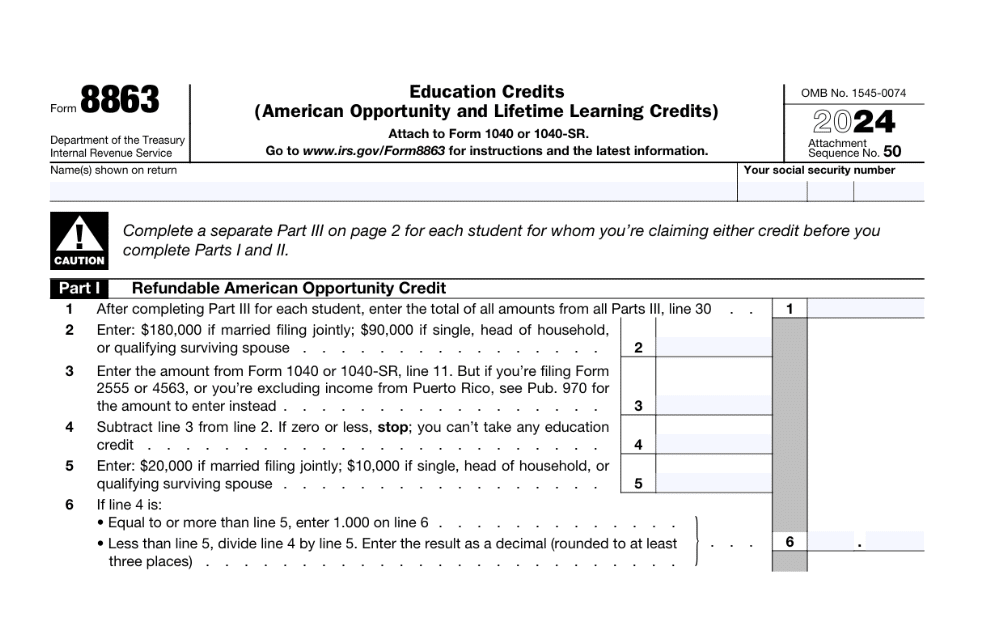Form 8863: How to File Education Credits as an American Expat

- What Is Form 8863 For?
- Who Is Eligible to Use Form 8863?
- Is Form 8863 Difficult to Fill Out?
- How Form 8863 Flows
- Common Form 8863 Challenges for Expats
- How Does Form 8863 Affect Your Tax Refund?
- Strategic Considerations for Expats
- When to Complete Form 8863
- Expat Filing Deadlines
- Missed Filings and Catch-Up Options
- Your Next Steps
Form 8863 is a two-page IRS form that calculates your exact education credit amount and transfers it to your tax return. Whether you’re claiming the American Opportunity Credit or Lifetime Learning Credit, this form handles the math and ensures you get every dollar you’re entitled to from education expenses.
For American expats, Form 8863 can be especially valuable since education credits are available for over 400 foreign universities that participate in US federal student aid programs. The key challenge for expats isn’t eligibility—it’s correctly calculating your Modified Adjusted Gross Income (MAGI) when you’ve used the Foreign Earned Income Exclusion.
What Is Form 8863 For?
Form 8863 serves one primary purpose: to calculate your education credit amount and transfer it to the correct lines on your Form 1040. The form doesn’t determine whether you qualify for education credits—that depends on factors like school eligibility and your income level. Instead, it does the mathematical heavy lifting once you’ve established eligibility.
The form handles two distinct calculations:
- American Opportunity Credit calculation: 100% of the first $2,000 in qualified expenses plus 25% of the next $2,000, up to a maximum $2,500 credit per student
- Lifetime Learning Credit calculation: 20% of qualified expenses up to $10,000, for a maximum $2,000 credit per tax return
You cannot claim both credits for the same student in the same year. Form 8863 will help you determine which credit provides the better benefit for your situation.
The completed form transfers your credit amount to Schedule 3 of Form 1040, where it reduces your tax liability dollar-for-dollar. For the American Opportunity Credit, up to $1,000 can be refundable, meaning you can receive it even if you owe no taxes.
For comprehensive information about education credit eligibility and which expenses qualify, see our detailed guide on claiming education credits while studying abroad.
Who Is Eligible to Use Form 8863?
Form 8863 eligibility centers on three main factors, with special considerations for American expats.
Basic Eligibility Requirements
You can file Form 8863 if:
- You, your spouse, or a dependent paid qualified education expenses in the tax year
- The student attended an eligible educational institution
- You meet the income requirements based on your Modified Adjusted Gross Income (MAGI)
- You weren’t a nonresident alien for any part of the tax year
The Expat MAGI Trap
Here’s where many expats get tripped up: If you claimed the Foreign Earned Income Exclusion on Form 2555, you must add that excluded income back when calculating MAGI for education credit purposes.
2025 Income Limits:
- Single filers: Credits phase out between $80,000-$90,000 MAGI
- Married filing jointly: Credits phase out between $160,000-$180,000 MAGI
Example: Tom lives in Thailand and earns $95,000 annually. He excludes the full amount using the FEIE, showing $0 adjusted gross income on his Form 1040. However, for Form 8863 purposes, his MAGI is $95,000 (the excluded amount added back), making him ineligible for education credits as a single filer.
If you’re married and both spouses claim the FEIE, you add back both exclusion amounts when calculating MAGI for education credits.
Is Form 8863 Difficult to Fill Out?
Form 8863 is relatively straightforward once you have the right information. The form uses a logical flow that guides you through the calculation process.
Information You’ll Need
Before starting Form 8863:
- Student Information: Name, Social Security Number, and relationship to you
- School Details: Institution name, address, and Employer Identification Number (EIN)
- Expense Records: Total qualified education expenses paid in 2024
- Form 1098-T: If the school issued one (many foreign schools don’t)
For Foreign Schools: If your school doesn’t have a US EIN, contact their financial aid office to see if they can obtain one. If not, you may still be eligible if you can prove the school participates in US federal student aid programs.
How Form 8863 Flows
- Part I – Student and Educational Institution Information: Enter basic details about each student and their school. If you have multiple students, complete a separate Part I for each.
- Part II – Expenses and Credits: This section does the math. You’ll enter qualified expenses, and the form calculates both the American Opportunity Credit and Lifetime Learning Credit to determine which provides the better benefit.
- Part III – Credit Limitation: This is where your MAGI matters. The form reduces your credit if your income falls in the phase-out range.

Currency Conversion for Expats: Convert foreign currency expenses to US dollars using the exchange rate from the date you paid the expenses. Use IRS approved exchange rates or a consistent commercial source.
Common Form 8863 Challenges for Expats
- Missing EIN: Many foreign schools don’t have US Employer Identification Numbers. Contact the school’s financial aid office to see if they can obtain one.
- No Form 1098-T: Most foreign schools don’t issue this form. You can still claim credits with alternative documentation like official receipts and enrollment verification.
- Currency Conversion Documentation: Keep detailed records of exchange rates used and payment dates for potential IRS review.
How Does Form 8863 Affect Your Tax Refund?
Form 8863 affects your tax situation differently depending on which credit you claim and your overall tax liability.
American Opportunity Credit and Refunds
The American Opportunity Credit is partially refundable, making it especially valuable for expats who use the Foreign Earned Income Exclusion and may owe little to no US taxes.
How the Refundable Portion Works:
- If the credit exceeds your tax liability, you can receive up to 40% of the remaining amount as a refund
- Maximum refundable portion is $1,000 per student
- You can receive this refund even if you owe $0 in taxes
Example: Lisa uses the FEIE and owes $0 in US taxes. She claims a $2,500 American Opportunity Credit for her daughter’s college expenses. Since she has no tax liability to offset, she receives a refund of $1,000 (40% of $2,500).
Lifetime Learning Credit Impact
The Lifetime Learning Credit is non-refundable, meaning it can only reduce your tax liability to zero—you won’t receive any unused portion as a refund.
For Expats with Low Tax Liability: If you use the FEIE and owe little to no US taxes, the Lifetime Learning Credit may provide no benefit. In this case, the American Opportunity Credit’s refundable portion makes it more valuable.
Strategic Considerations for Expats
FEIE vs Foreign Tax Credit: If you’re choosing between the Foreign Earned Income Exclusion and Foreign Tax Credit, consider how each affects your education credits:
- FEIE Strategy: May eliminate tax liability but preserves the refundable portion of American Opportunity Credit
- Foreign Tax Credit Strategy: May leave you with tax liability that education credits can offset, potentially providing more total benefit
When to Complete Form 8863
Required Filing Situations
You must file Form 8863 if you want to claim any education credit. The form cannot be filed separately—it must be attached to your Form 1040 or 1040-SR.
Academic Year Timing
You can claim expenses paid in 2025 for academic periods that began in 2025 or the first three months of 2026. This means December 2025 tuition payments for spring 2026 semester can be claimed on your 2025 return.
Expat Filing Deadlines
- Automatic Extension: American expats receive an automatic two-month extension, moving the filing deadline from April 15 to June 15. Form 8863 follows this same timeline.
- Additional Extensions: You can request further extensions to October 15 using Form 4868 if needed.
Record Keeping Requirements
Maintain documentation for at least three years after filing:
- All receipts for qualified education expenses
- Enrollment verification from foreign institutions
- Currency conversion calculations and exchange rate sources
- Any correspondence with schools about EIN numbers
Missed Filings and Catch-Up Options
You have options if you’ve been behind on filing taxes and missed claiming education credits.
Streamlined Filing Procedures
The Streamlined Filing Procedures allow qualifying expats to catch up on three years of tax returns without penalties. This includes claiming missed education credits that could result in refunds.
Key Benefits:
- File three years of delinquent returns
- Claim education credits you missed
- No penalties if your failure to file was non-willful
- Potential refunds from unclaimed American Opportunity Credits
Amended Returns
If you filed returns but missed claiming education credits, you can file Form 1040-X to amend prior year returns. You have three years from the original due date to claim missed credits.
Your Next Steps
If you paid education expenses in 2024, here’s your action plan:
- Verify School Eligibility: Check if your institution appears on the Federal Student Aid website
- Calculate Your MAGI: Add back any excluded foreign income to determine credit eligibility
- Gather Documentation: Collect receipts, enrollment records, and EIN information
- Download Form 8863: Get the current version from the IRS website
- Complete the Form: Follow the line-by-line instructions
Remember, Form 8863 is just one part of your expat tax strategy. The interaction between education credits and other expat benefits like the Foreign Earned Income Exclusion requires careful planning to maximize your overall savings.
No matter how complex your education credit situation may be, you’ll have peace of mind knowing that your taxes were done right. If you realize you’re in over your head and worried that you’ll mess it up, let us help. Contact us, and one of our Customer Champions will happily address all your concerns.
Whether you’re years behind or just unsure about the thresholds, our team is ready to help.
The information provided here is for general guidance only and does not constitute personalized tax advice. Tax laws change frequently, and individual circumstances vary. Always consult with a qualified tax professional for advice specific to your situation.


